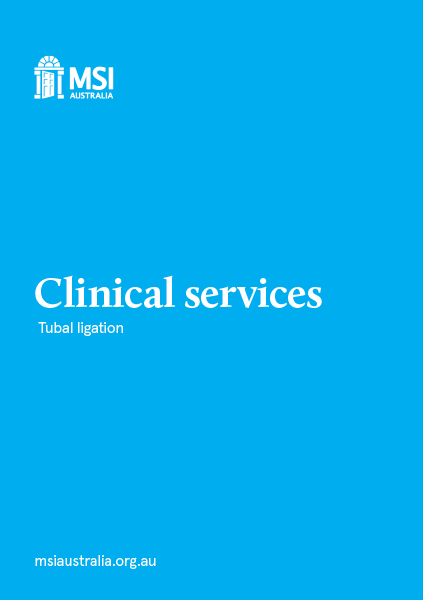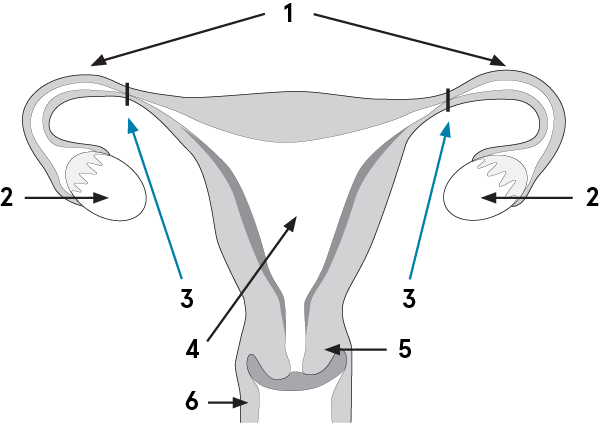Clinical Services
Tubal Ligation

Clinical Services: Tubal Ligation
PDF versions available: Clinical Services: Tubal Ligation (ENG, PDF 1MB)
Ref code: 1621-MSIAU-230821
This page contains information about your medical abortion. Read this information carefully and keep it to look at later on. Ask us if you have any questions after reading it.
Things to know
Consent
This page contains information about your tubal ligation. Read this information carefully and keep it to look at later. Ask us if you have any questions after reading it.
- It is important that you understand the process, any risks, and that you are sure about your choice.
- Risks of tubal ligation are described in the risks section.
- We will ask you to give your written consent to the procedure.
- It is important that you understand our fees and charges so you can give informed financial consent.
If you do not understand anything in this booklet, you have any questions, or if you feel that you’re being pressured or coerced, please let us know.
Interpreter services
Please let us know if you need a telephone interpreter to help you understand any of this information. If you need one at any time before or after your procedure, you can call: TIS National on 131 450 and ask to be connected to us on 1300 003 707.
Make a complaint or provide feedback
If you would like to provide any feedback, you can:
- talk to any staff member at the clinic
- write directly to the clinic
- call our National Contact Centre on 1300 003 707
- use our feedback form on the homepage of our website.
If we don’t satisfy your concerns, you may also escalate your complaint to the independent body in your State.
What is tubal ligation (female sterilisation)?
Tubal ligation is a permanent form of contraception for women and people with a uterus. It is a surgical procedure, performed under general anaesthetic, whereby a small clip is placed on each fallopian tube to stop the egg from travelling from the ovary to the uterus. This blocks the fallopian tubes, preventing the egg and sperm from meeting and stopping a pregnancy from developing. An egg is still released with ovulation, but it is absorbed by the body.
How effective is the procedure?
Tubal ligation is more than 99.5% effective. As the procedure is not 100% effective, failures can happen, even many years following the tubal ligation. If you do become pregnant after sterilisation, there is an increased chance of having an ectopic pregnancy (pregnancy outside the uterus).
You should be able to have sexual intercourse 1 week after a tubal ligation. It’s important to remember that tubal ligation does not protect you against sexually transmitted infections (STIs). You should still consider using condoms as protection against STIs.
Alternatives to tubal ligation
Alternatives to tubal ligation
There are non-permanent (reversible) methods of contraception available as an alternative to tubal ligation. These include:
- contraceptive implant/rod in your arm
- hormonal and copper intrauterine devices
- contraceptive injections
- oral contraceptive pill
Vasectomy is a permanent method of sterilisation for men and people with testicles.
How is the procedure performed?
Tubal ligation is performed using a laparoscopic (keyhole) technique. This means that 2-3 small incisions (cuts) are made in the abdomen (tummy): 1 through the umbilicus (belly button) and the other at the pubic hairline.
Air is used to gently inflate your abdomen and then a telescopic camera is inserted through the incision in the belly button to view your fallopian tubes.
Through the second incision, a small device is inserted, which is loaded with the Filsche clip. The clip is then placed on the fallopian tube which seals the tube. The process is then repeated on the other tube.
Once both tubes are clipped, the instruments are removed, and the incision sites are closed with dissolving stiches and waterproof dressings are placed over the wounds.

- Fallopian tubes
- Ovary
- Filsche clip
- Uterus (womb)
- Cervix
- Vagina
What are the risks?
Laparoscopic procedures are common and safe procedures. According to RANZCOG (Royal Australian and New Zealand College of Obstetricians and Gynaecologists) the rate of complications in all laparoscopic procedures is less than 1% (1 in 100), with the risk of major complications less than 0.5% (1 in 200).
Potential complications can include:
- damage to the internal organs, such as bowel, bladder, ureter, and damage to blood vessels
- excessive bleeding
- infection
- surgical emphysema (where the air becomes trapped in your skin)
- risks of general anaesthesia
- failed procedure
How to prepare for your procedure
Using reliable contraception before your procedure
It’s very important that you use a reliable form of contraception until the procedure. This is to prevent a very early pregnancy that may not be detected on a pregnancy test at this time.
It is expected that you will spend between 2-3 hours at the clinic, depending on your recovery time.
Fasting
Do not eat or drink anything (including chewing gum or lollies) for 6 hours before your appointment time.
You may have a small glass of water each hour up to 2 hours before your appointment, but no other fluid.
If you don’t follow this, we may need to cancel or reschedule your procedure.
For more information on how to prepare for general anaesthesia, please read the Sedation Information booklet.
After your procedure
As you will have had a general anaesthetic, you cannot drive a motor vehicle for 24 hours after your appointment. You must have a responsible adult pick you up from the clinic following your procedure.
For more information on how to recover from the anaesthetic, please read the Sedation Information booklet.
Rest
When you get home from the clinic, rest and try not to do too much. You should be able to resume normal activities after 2-3 days. The effects of the anaesthetic may make you feel tired.
How to avoid infection
Avoid the following for 1 week following your procedure:
- inserting anything into the vagina, including sexual intercourse, tampons, fingers, menstrual cups, etc.
- swimming or baths (showers are allowed).
If you experience any vaginal blood loss, please only use sanitary pads (do not use tampons as they can increase a chance of infection).
Signs of possible infection
You may have an infection if you have any of the following:
- fever (temperature and chills)
- red and painful wounds in your abdomen (tummy)
- pain in your abdomen (tummy) that doesn’t get better with pain killers
- an offensive and smelly discharge from your vagina.
If you are concerned at all call our free aftercare line at any time on 1300 888 022.
Pain management
You may experience some pain at the site of the incisions (cuts) as well as abdominal (tummy) discomfort and bloating for the first few days after your procedure. The air used to inflate your tummy may cause bloating and shoulder tip pain for a few days.
If you have any pain, you may take over the counter painkillers such as paracetamol or ibuprofen. We will also provide prescription medication.
Dressings
The dressings on your abdomen need to stay in place for 5 days after your surgery.
Gently peel back the clear plastic dressings after 5 days, and the small, white strip dressings can stay in place until they fall off (or after 10 days). The stiches will dissolve over time – there is no need to have these removed.
You may shower as normal – make sure the wound sites/dressing are patted dry after showering to keep dry. Do not rub the wound sites as this can delay healing and/or cause pain.
Menstrual cycle
Your menstrual cycle (period) should not be affected by the procedure – your period should arrive as per your normal cycle.
If your period has not arrived after 6 weeks, please see your GP for follow up.
Free aftercare line
Our aftercare phone service connects you to experienced registered nurses, at any time of the day or night.
Call our aftercare nurses on 1300 888 022 if you experience any of the following problems or have any concerns:
- fever (temperature and chills)
- red and painful wounds in your abdomen (tummy)
- pain in your abdomen (tummy) that doesn’t get better with pain killers
- an offensive and smelly discharge from your vagina.
Your Healthcare Rights
MSI Australia adopts the Australian Charter of Healthcare Rights. The Charter provides a framework of client rights which allows clients, families, carers and services providing health care to work together towards a safe and high quality health system, achieving the best possible outcomes.
The Charter is guided by the following principles:
- Access
- Safety
- Respect
- Partnership
- Information
- Privacy
- Give feedback
As a client of MSI Australia, you have a right to:
- be treated in a professional, courteous, and caring manner
- be respected regardless of your gender, age, sexual orientation, disability, religion, and cultural and linguistic diversity
- have your concerns, complaints and suggestions taken seriously.
If we don’t satisfy your concerns, you may also escalate your complaint to the independent body in your State or Territory.
For more information about your healthcare rights and the Charter, head to safetyandquality.gov.au.
This page last edited: August 2023
Ref: 0621-MSA 201124 / 1621-MSIAU 230821
